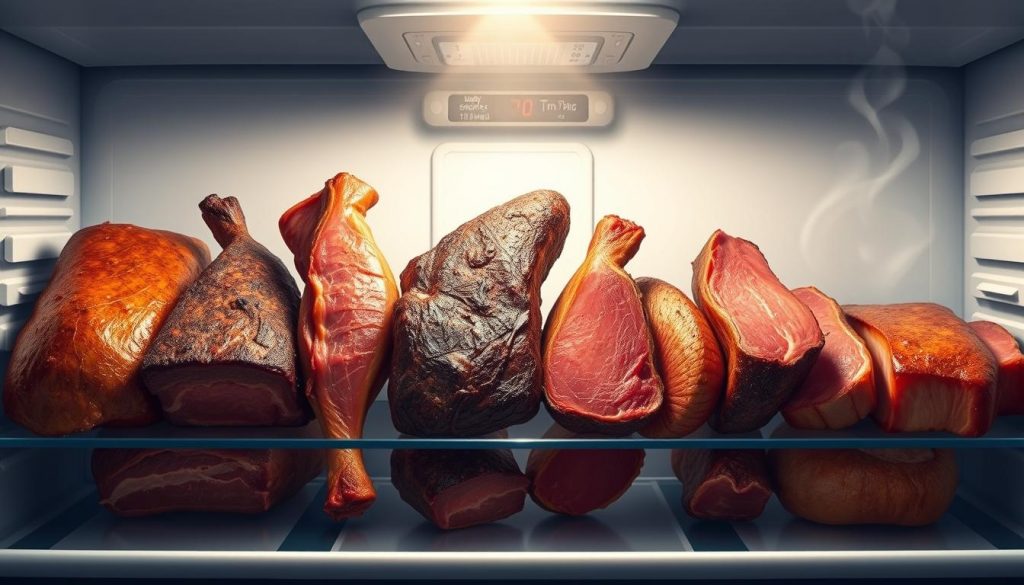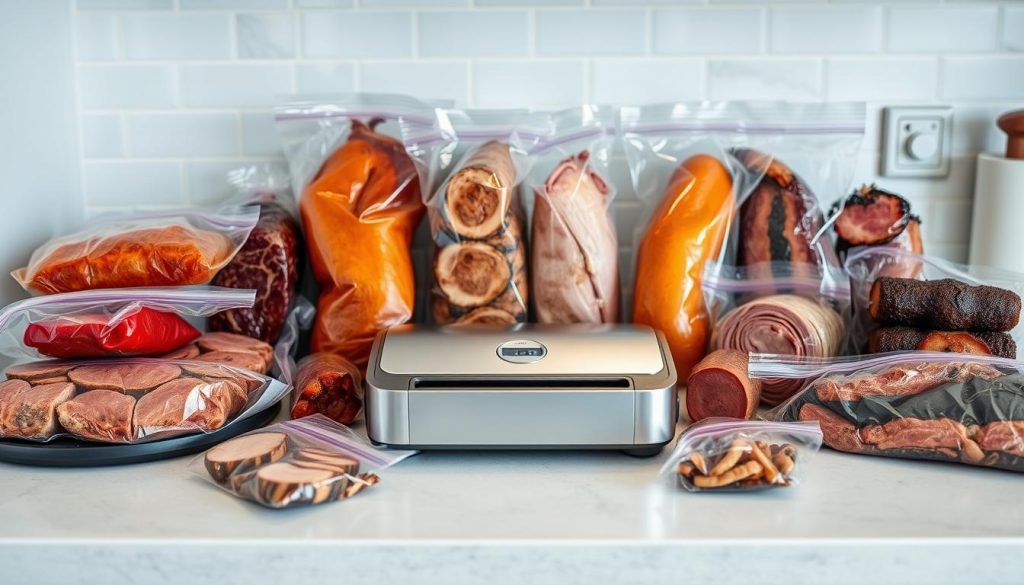Smoked meat is tasty, but proper storage keeps it safe and delicious. Let’s explore how to store and refrigerate smoked meat. We’ll focus on food safety to help you enjoy your smoky treats longer.
Each type of smoked meat has unique storage needs. We’ll look at factors affecting shelf life and share expert tips. This guide will help you master smoked meat storage.
Whether you love brisket, ribs, or smoked salmon, you’ll find useful information here. Our goal is to help you keep your smoked meats fresh and safe to eat.
Key Takeaways
- Proper refrigeration is crucial for smoked meat safety
- Different smoked meats have varying storage times
- Temperature control plays a vital role in preservation
- Curing can extend the shelf life of smoked meats
- Knowing signs of spoilage is essential for food safety
Understanding Smoked Meat Storage Basics
Smoked meat storage blends tradition with science. We’ll cover how to keep your smoked treats fresh and safe. Mastering these basics ensures your meats stay tasty for longer.
Different Types of Smoking Methods
Smoking techniques impact meat preservation. Cold smoking and hot smoking are two main methods. Cold smoking happens below 85°F, adding flavor without fully cooking the meat.
Hot smoking cooks meat at 165°F to 185°F. This method creates a ready-to-eat product. Both methods offer unique benefits for preserving meat.
The Role of Temperature in Preservation
Temperature control is key for smoked meat longevity. Proper cooling after smoking stops bacteria from growing. Refrigeration at 40°F or below slows spoilage.
Freezing at 0°F can keep meat fresh for months. Always monitor temperatures to ensure safe storage.
Impact of Curing on Storage Life
Curing methods boost smoked meat preservation. Salt, sugar, and nitrites work to stop bacteria and add flavor. Dry curing and wet curing are common techniques.
These methods extend storage life when combined with proper smoking and refrigeration. Curing adds an extra layer of protection to your smoked meats.
| Smoking Method | Temperature Range | Preservation Impact |
|---|---|---|
| Cold Smoking | Below 85°F | Flavor infusion, minimal preservation |
| Hot Smoking | 165°F – 185°F | Fully cooked, better preservation |
| Curing + Smoking | Varies | Extended shelf life, enhanced flavor |
How Long Does Smoked Meat Last in the Fridge
Proper storage of smoked meats is vital for quality and safety. This guide will help you understand how long different smoked meats can last in your fridge.
Storage Times for Different Smoked Meats
Smoked meats have varying shelf lives. Smoked beef stays fresh for 3-4 days in the fridge. Smoked pork lasts 4-5 days, while smoked poultry is good for 2-3 days.
| Meat Type | Refrigeration Time |
|---|---|
| Smoked Beef | 3-4 days |
| Smoked Pork | 4-5 days |
| Smoked Poultry | 2-3 days |
Signs of Proper Storage
Well-stored smoked meat keeps its color and texture. The smell should be pleasant, not sour or off-putting. If you spot changes, it’s best to toss the meat.
Maximum Storage Duration Guidelines
Eat smoked meats within the suggested time for best flavor and safety. Can’t eat them soon? Freeze them for up to 3 months.
“When in doubt, throw it out. It’s always better to be safe than sorry when it comes to food safety.”
These guidelines apply to refrigerated meats. Always handle food properly to ensure the best quality and safety of your smoked meats.
Proper Storage Techniques for Smoked Meats
Storing smoked meats correctly keeps them flavorful and safe. These best practices will help you maintain freshness for longer.
Airtight containers are essential for storing smoked meats. They prevent air exposure, which can cause oxidation and spoilage. Wrap your meat in plastic wrap or foil before placing it in the container.
Refrigeration is crucial for preserving smoked meats. Keep your fridge at 40°F (4°C) or below to slow bacterial growth. Place wrapped meat on the bottom shelf to avoid drips onto other foods.
Plastic wrap works well for short-term storage. It clings tightly, creating a barrier against air and moisture. When using foil, wrap the meat tightly and crimp the edges.
“Proper storage is key to enjoying your smoked meats at their best. With the right techniques, you can savor that smoky flavor for days to come.”
Label your stored meats with the smoking date. This helps you track freshness and use older items first. Following these techniques ensures your smoked meats stay tasty and safe.
Factors Affecting Smoked Meat Shelf Life
Several key factors impact how long smoked meat lasts. Meat freshness, smoking time, container choice, and temperature all play crucial roles. Let’s explore how these elements preserve your tasty smoked treats.
Initial Meat Quality
Fresh meat is crucial for longer-lasting smoked products. High-quality cuts have fewer bacteria, extending their shelf life after smoking. Choose meat from trusted sources and check for freshness before smoking.
Smoking Process Variables
Longer smoking times reduce moisture, slowing bacterial growth. The type of wood used affects flavor and preservation. These factors impact how long your smoked meat stays good.

Storage Container Selection
Choosing the right container is key to keeping smoked meat fresh. Airtight containers prevent oxidation and moisture loss. Glass or food-grade plastic work well. Vacuum-sealed bags offer the best protection.
Temperature Fluctuations
Steady temperature is vital for preserving smoked meats. Changes can cause condensation, which promotes bacterial growth. Keep your fridge at 40°F (4°C) or below for maximum shelf life.
| Factor | Impact on Shelf Life |
|---|---|
| Meat Freshness | High impact |
| Smoking Duration | Moderate impact |
| Container Materials | Significant impact |
| Temperature Control | Critical impact |
These factors can greatly extend your smoked meat’s shelf life. Good storage techniques work with these elements to keep your smoked treats safe. Follow these tips to enjoy delicious smoked meats for longer.
Signs of Spoilage in Smoked Meats
Spotting spoiled smoked meat is vital for food safety. Here’s a list of key signs to help you identify bad smoked meats. Your health depends on recognizing these indicators.
Off-odors often signal spoilage first. Fresh smoked meat should smell pleasantly smoky. Sour, rancid, or ammonia-like odors mean it’s time to toss it out.
Discoloration is another clear sign. Smoked meats are naturally dark, but unusual changes indicate spoilage. Watch for greenish or grayish hues and slimy films on the surface.
Mold growth means your smoked meat has gone bad. Fuzzy patches of any color are a red flag. Throw away moldy meat right away.
Texture changes can also show spoilage. Fresh smoked meat should feel firm. Slimy, sticky, or overly soft textures mean it’s past its prime.
| Spoilage Sign | What to Look For | Action Required |
|---|---|---|
| Off-odors | Sour, rancid, or ammonia-like smells | Discard immediately |
| Discoloration | Greenish or grayish hues, slimy film | Throw away |
| Mold growth | Fuzzy patches of any color | Dispose of meat |
| Texture changes | Slimy, sticky, or overly soft consistency | Do not consume |
Trust your senses when checking smoked meat. If something seems off, it’s safer to throw it out. Eating spoiled meat can cause illness, so stay alert and cautious.
Best Practices for Refrigeration
Proper refrigeration keeps smoked meats fresh and safe. Let’s look at the best ways to store your tasty smoked creations in the fridge.
Optimal Temperature Settings
Fridge temperature is crucial for food storage. Set it between 34°F and 40°F (1°C to 4°C) to slow bacterial growth. This range helps maintain meat quality.
Use a thermometer to check the temperature often. Regular checks ensure your fridge stays in the safe zone.
Humidity Control Methods
Controlling humidity prevents moisture loss or excess dampness. Use crisper drawers for smoked meats, as they offer a controlled environment.
If your fridge lacks humidity controls, try this trick. Wrap meats in wax paper before placing them in airtight containers.
Air Circulation Requirements
Good air flow is key for even cooling. It prevents hot spots in your fridge. Avoid overcrowding and leave space between items.
This practice ensures consistent temperatures throughout. It also helps maintain food quality for longer.
Proper storage can extend your smoked meats’ life. Some smokers claim their meats last up to two weeks when stored right. Always follow FDA guidelines for food safety.
| Factor | Recommendation |
|---|---|
| Temperature | 34°F – 40°F (1°C – 4°C) |
| Humidity | Use crisper drawers or wrap in wax paper |
| Air Circulation | Avoid overcrowding, leave space between items |
Freezing Smoked Meats for Extended Storage
Freezing can keep your smoked meats fresh for months. Let’s look at the best ways to store them in your freezer. These methods will help maintain their flavor and quality.
Good packaging prevents freezer burn. Wrap meats tightly in plastic wrap, then put them in freezer bags. Remove as much air as possible before sealing.
Thaw meats slowly for best results. Put frozen meats in the fridge 24 hours before use. This helps keep the texture and flavor intact.
- Label packages with contents and date
- Use within 3-6 months for best quality
- Avoid refreezing thawed meats
Vacuum sealing is great for preventing freezer burn. It removes all air, creating a tight seal. This protects against moisture loss and keeps meats fresh.
“Proper freezer storage can keep smoked meats delicious for up to six months, preserving that perfect smoky flavor.”
Keep your freezer at 0°F (-18°C) or below. Steady temperatures prevent ice crystals from forming. This helps maintain the meat’s texture and taste.
Follow these tips to enjoy your smoked meats long after they leave the smoker. Your frozen meats will stay tasty for months to come.
Vacuum Sealing Benefits for Smoked Meat Storage
Vacuum sealers are game-changers for preserving smoked meats. They remove air from storage bags, creating an airtight environment. This keeps food fresh longer and enhances your smoked meat storage.
Equipment Recommendations
Choose vacuum sealers with adjustable settings and durable construction. Models with double sealing bars offer extra protection. Top brands include FoodSaver, Nesco, and VacMaster.

Proper Sealing Techniques
To get the best results:
- Cool meats completely before sealing
- Pat dry to remove excess moisture
- Leave some space at the top of the bag
- Use textured bags for better air removal
- Double-seal the ends for extra protection
Storage Duration Benefits
Vacuum sealing extends shelf life by removing oxygen. Smoked meats stored this way last much longer.
| Storage Method | Refrigerated | Frozen |
|---|---|---|
| Regular Storage | 3-4 days | 2-3 months |
| Vacuum Sealed | 2-3 weeks | 6-12 months |
Invest in quality vacuum sealers and master proper techniques. You’ll enjoy your smoked meats for longer while maintaining their flavor and quality.
Reheating and Serving Stored Smoked Meats
Proper reheating is vital for food safety and flavor when enjoying stored smoked meats. Use gentle methods to avoid drying out your tasty treats. The oven at 250°F works well for larger cuts.
For smaller portions, use a skillet on medium-low heat. Serving temperature matters for taste and safety. Use a meat thermometer to ensure internal temperature reaches 165°F before serving.
To keep meats juicy, add some broth or water to the pan. This trick maintains moisture and enhances flavor. For a crispy exterior, finish under the broiler briefly.
Watch closely to prevent burning. By following these methods, you’ll savor rich flavors as if freshly prepared. Enjoy your delicious smoked meats!




